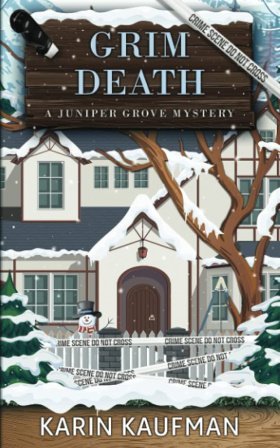“Maybe. We don’t know for sure when that photo was taken.”
It was taken outside Grove Coffee, I was sure of that. Continuing to study it for clues, I spotted a dated flyer in the window. “Wait a sec. We do know when it was taken. Look at the flyer taped to the glass, to the right of Dalton. It’s for a Christmas concert at Town Hall, year before last.”
Gilroy squinted, held the photo closer. He whistled. “Detective Stowe-Gilroy. I remember that flyer. All over town.”
“Grove Coffee doesn’t leave old flyers in their windows. They have too many new ones to post. So this was taken more than two years ago, well before his divorce. And he had the nerve to accuse his wife of adultery?”
“Let’s not jump to conclusions. We don’t know Alison’s part in their divorce.”
“Agreed.” I took a long, slow sip of coffee, savoring the toasty hazelnut flavor. “So why was Mary given the photo? What’s she supposed to do about Dalton’s old affair?”
“Maybe it’s an ongoing affair.”
“Shasta can’t stand the guy. Trust me.”
“She did cut him down to size a couple times.” Gilroy stuck out his hand. “Give me that Idaho police report.”
I handed him the report then propped my feet on the coffee table, cradled my cup, and stared into the fire. James and I could go only so far without knowing who gave the papers and photo to Mary—and why she’d been the recipient. Presuming she knew the answers to those questions. If she did know, there was no need to involve me. Unless all she wanted was advice.
“I have to talk to Mary,” I said.
“Umm.”
I laid my head on his shoulder. “Do you think that report’s real?”
“I’d bet on it. Look at this. A blood alcohol level of .14. Injuring Eamon Keegan—or worse. It doesn’t say if he survived. Brodie might’ve done time. I wonder if the Post knew about this before they hired him.”
“They hired him out of Nebraska, so maybe not. Maybe he moved to Lincoln to escape his past.” Replaying the brunch in my mind—where was everyone standing when James and I arrived and where did I first see Brodie?—I tried to remember if he’d had a champagne flute or any other kind of glass in his hands. “He wasn’t drinking a mimosa in the living room. He had a cup of coffee at the table, that’s all.”
“He wasn’t drinking anything in the living room.” Gilroy handed me the police report and took up the photocopy of the Blackwells’ second mortgage.
I focused on the third sheet of paper, the disturbing accusation against Isak Karlsen. Nine years ago, a sixteen-year-old student named Sophia Geller accused Isak of what was termed “sexual misconduct” at Tilton Academy in St. Paul. As an eighteen year old, she’d sued Isak and the school, alleging that the school had been made aware of the misconduct but had refused to take action. Tilton considered it a matter of he said-she said, and the police had never been called.
Isak would’ve been about twenty-eight or thirty at the time, I thought. Younger, dumber. But the sort of man who would assault a girl?
But what sort of man was he, really? Truth was, I barely knew him.
Had Geller’s lawsuit proceeded? Given my resources—the internet, Gilroy’s access to virtually any police record, and even willing acquaintances at Town Hall—it seemed an answerable question.
“What do these look like to you?” I asked, making a sweeping motion with my coffee cup.
“What do you mean?”
“This is personal, damaging stuff. Someone gave Mary four pieces of juicy gossip.”
“True,” he said slowly.
I could practically hear the wheels turning in his head. “And Mary—”
“—works for the Post,” he finished. “You think someone wants this stuff in print?”
“Why else would someone give these papers to her?”
“First, we don’t know if someone gave them to her. Right now we don’t know anything. Second, Brodie Keegan is the editor, isn’t he?”
“That’s what Clay said when he introduced him.”
“So he’d be the one who decides what stories get printed, not Mary. And this,” he said, tapping the photocopy of the Blackwells’ mortgage, “is an outlier. It isn’t newsworthy, even for the Post. ‘Clay Blackwell mortgages home to finance his art gallery’?”
“Or ‘Clay Blackwell mortgages home to pay off debts.’ Either way, you’re right. It would mean something to Mary, but only if she didn’t know he took out a second mortgage. For goodness’ sake, why didn’t she just tell me when we were at the brunch? Instead she hands me a note and vanishes. It’s almost comical.” I swung my feet off the coffee table, sat up, and downed the rest of my coffee. “We’re operating on zero info. I’m going to call her.”
“Why not wait until tonight?”
“One, I’m terribly impatient.”
“Agreed.”
“And two, I want to hear what you think about what she tells me, and I have a feeling we’ll both be too tired to discuss it after dinner.”
“Being sociable is draining.”
“You know, some couples go out with other couples once a week, not once a month.”
“Let’s not get carried away. Moderation in all things.”
I went to the kitchen, pulled my phone from my coat pocket, and hit Mary’s number, hoping Mary, not Clay, would answer.
I waited, listening to the fire softly crackling in the living room. Eight rings later, Mary answered.

























